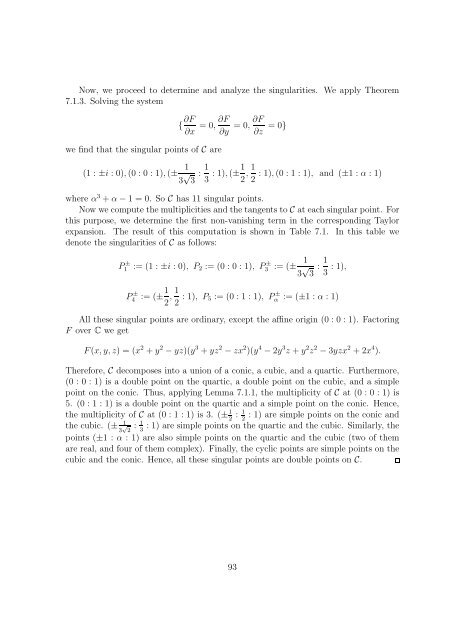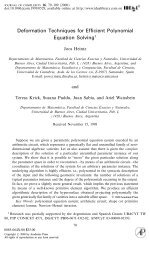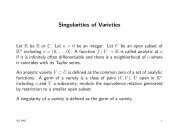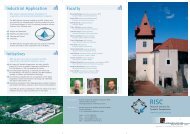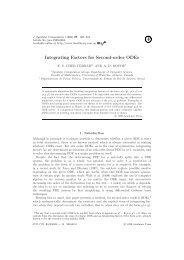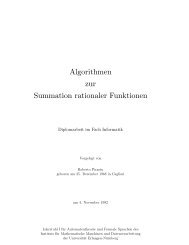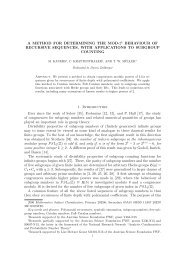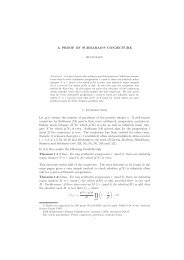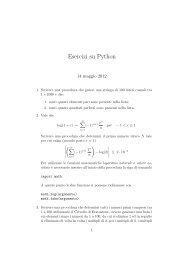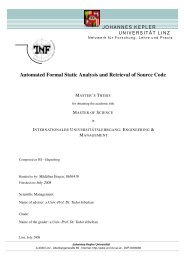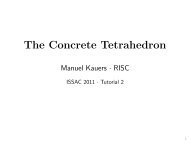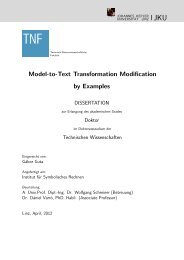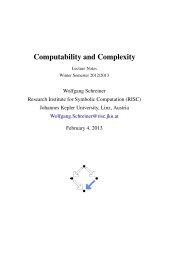Chapter 7 Local properties of plane algebraic curves - RISC
Chapter 7 Local properties of plane algebraic curves - RISC
Chapter 7 Local properties of plane algebraic curves - RISC
Create successful ePaper yourself
Turn your PDF publications into a flip-book with our unique Google optimized e-Paper software.
Now, we proceed to determine and analyze the singularities. We apply Theorem<br />
7.1.3. Solving the system<br />
{ ∂F<br />
∂x<br />
= 0,<br />
∂F<br />
∂y<br />
= 0,<br />
∂F<br />
∂z = 0}<br />
we find that the singular points <strong>of</strong> C are<br />
(1 : ±i : 0), (0 : 0 : 1), (± 1<br />
3 √ 3 : 1 3 : 1), (±1 2 , 1 : 1), (0 : 1 : 1), and (±1 : α : 1)<br />
2<br />
where α 3 + α − 1 = 0. So C has 11 singular points.<br />
Now we compute the multiplicities and the tangents to C at each singular point. For<br />
this purpose, we determine the first non-vanishing term in the corresponding Taylor<br />
expansion. The result <strong>of</strong> this computation is shown in Table 7.1. In this table we<br />
denote the singularities <strong>of</strong> C as follows:<br />
P ± 1 := (1 : ±i : 0), P 2 := (0 : 0 : 1), P ± 3 := (± 1<br />
3 √ 3 : 1 3 : 1),<br />
P ± 4 := (±1 2 , 1 2 : 1), P 5 := (0 : 1 : 1), P ± α<br />
:= (±1 : α : 1)<br />
All these singular points are ordinary, except the affine origin (0 : 0 : 1). Factoring<br />
F over C we get<br />
F(x, y, z) = (x 2 + y 2 − yz)(y 3 + yz 2 − zx 2 )(y 4 − 2y 3 z + y 2 z 2 − 3yzx 2 + 2x 4 ).<br />
Therefore, C decomposes into a union <strong>of</strong> a conic, a cubic, and a quartic. Furthermore,<br />
(0 : 0 : 1) is a double point on the quartic, a double point on the cubic, and a simple<br />
point on the conic. Thus, applying Lemma 7.1.1, the multiplicity <strong>of</strong> C at (0 : 0 : 1) is<br />
5. (0 : 1 : 1) is a double point on the quartic and a simple point on the conic. Hence,<br />
the multiplicity <strong>of</strong> C at (0 : 1 : 1) is 3. (± 1 : 1 : 1) are simple points on the conic and<br />
2 2<br />
the cubic. (± 1<br />
3 √ : 1 : 1) are simple points on the quartic and the cubic. Similarly, the<br />
2 3<br />
points (±1 : α : 1) are also simple points on the quartic and the cubic (two <strong>of</strong> them<br />
are real, and four <strong>of</strong> them complex). Finally, the cyclic points are simple points on the<br />
cubic and the conic. Hence, all these singular points are double points on C.<br />
93


